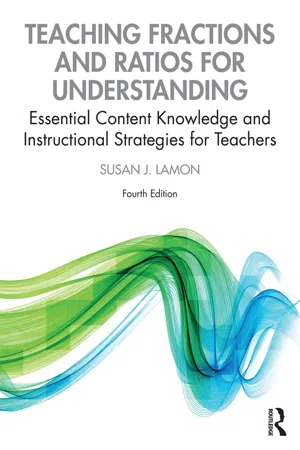
Teaching Fractions and Ratios for Understanding
Essential Content Knowledge and Instructional Strategies for Teachers
- 280 pages
- English
- ePUB (mobile friendly)
- Available on iOS & Android
Teaching Fractions and Ratios for Understanding
Essential Content Knowledge and Instructional Strategies for Teachers
About this book
Written in a user-friendly, conversational style, the fourth edition of this groundbreaking text helps pre-service and in-service mathematics teachers build the comfort and confidence they need to begin talking to children about fractions and ratios, distilling complex ideas and translating research into usable ideas for the classroom.
For two decades, Teaching Fractions and Ratios for Understanding has pushed readers beyond the limits of their current understanding of fractions and rational numbers, challenging them to refine and explain their thinking without falling back on rules and procedures they have relied on throughout their lives. All of the material offered in the book has been used with students, and is presented so that readers can see the brilliance of their insights as well as the issues that challenge their understanding. Each chapter includes children's strategies and samples of student work for teacher analysis, as well as activities for practicing each thinking strategy, designed to be solved without rules or algorithms, using reasoning alone.
The fourth edition of this popular text has been updated throughout and includes new examples of student work, updated artwork, and more.
As with previous editions, an equally valuable component of this text is the companion book MORE! Teaching Fractions and Ratios for Understanding (2012), a supplement that is not merely an answer key but a resource that provides the scaffolding for the groundbreaking approach to fraction and ratio instruction explored here. MORE! includes in-depth discussions of selected problems in the main text, supplementary activities, Praxis preparation questions, more student work, and templates for key manipulatives.
Frequently asked questions
- Essential is ideal for learners and professionals who enjoy exploring a wide range of subjects. Access the Essential Library with 800,000+ trusted titles and best-sellers across business, personal growth, and the humanities. Includes unlimited reading time and Standard Read Aloud voice.
- Complete: Perfect for advanced learners and researchers needing full, unrestricted access. Unlock 1.4M+ books across hundreds of subjects, including academic and specialized titles. The Complete Plan also includes advanced features like Premium Read Aloud and Research Assistant.
Please note we cannot support devices running on iOS 13 and Android 7 or earlier. Learn more about using the app.
Information
Chapter 1
Proportional Reasoning: An Overview


Introduction
The Constant of Proportionality
Table of contents
- Cover
- Half Title
- Title Page
- Copyright Page
- Dedication
- Table of Contents
- Preface
- Chapter 1 Proportional Reasoning: An Overview
- Chapter 2 Fractions and Rational Numbers
- Chapter 3 Relative Thinking and Measurement
- Chapter 4 Quantities and Covariation
- Chapter 5 Proportional Reasoning
- Chapter 6 Reasoning with Fractions
- Chapter 7 Fractions as Part–Whole Comparisons
- Chapter 8 Fractions as Quotients
- Chapter 9 Fractions as Operators
- Chapter 10 Fractions as Measures
- Chapter 11 Ratios and Rates
- Chapter 12 Changing Instruction
- Index